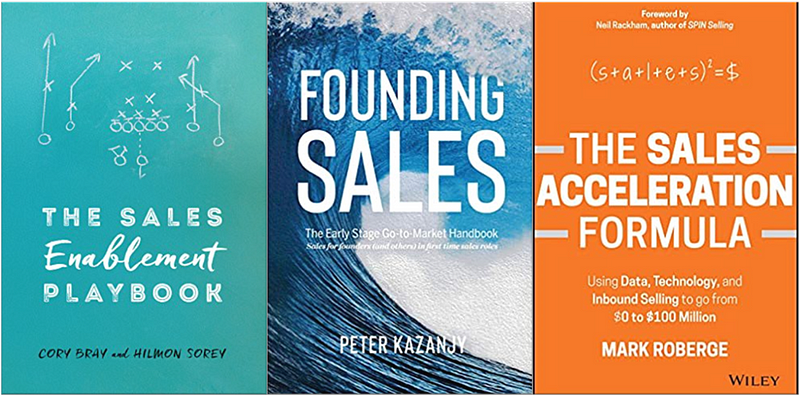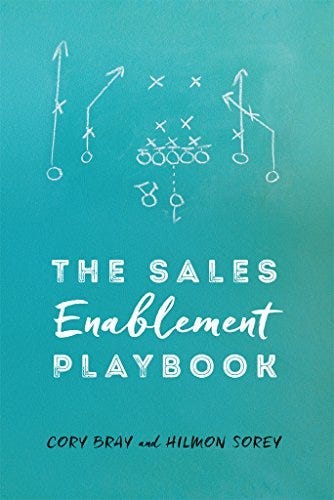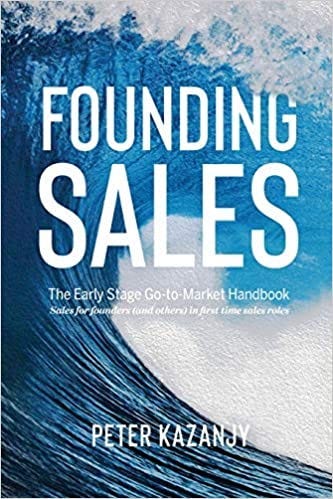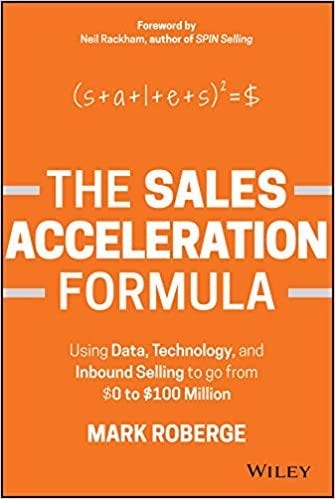What B2B Marketers Should Read About Sales
Three books that can help you help your sales team — and improve your marketing chops in the process
My firm invests in small technology companies, so we spend a lot of time thinking about growth.
When considering a new investment, we work hard to develop a perspective on how we can help the team improve their growth prospects. We get close with our Sales and Marketing leaders early. Understanding what’s working for them (and, maybe more importantly, what they haven’t gotten around to yet) is the most important part of building out our initial value-creation plan. We use that plan to measure success in the first year of our investment. It’s our north star.
But executing is never easy. Why is that? Well, to start, small-company Sales and Marketing leaders often work in siloes. While marketers are focused on running campaigns, pumping out content, and driving potential customers into their funnel, they’re quick to confess that they’re not as connected to “what Sales is doing” as they should be. And we often get a knowing chuckle from the Sales team when we describe the symptoms of “Deal A.D.D.” — a function-wide psychological affliction characterized by a frantic, jittery, short-term focus on new business. Symptoms include an all-consuming preoccupation with closing the next potential customer, hitting this quarter’s revenue target, and adding the next logo to their customer list. Basically, working in the sales process instead of on the sales process.
The Sales/Marketing relationship that often ensues can feel more swim-team than water polo. The two functions stay in their lanes, paddle like hell, and, every so often, glance over to see how the other is keeping up. And sometimes, that works just fine. For a while. But at some point, predictable, sustainable growth requires Sales and Marketing to work together. That takes trust, alignment, and a shared understanding of where you’re trying to go and how you’ll get here.
So who’s responsible for getting Sales and Marketing on the same page? The CEO? Well, yeah, ideally. But they’re busy. You know, running the company. Aligning Sales and Marketing is rarely their top priority. As a result, if you’re a leader in one of these functions, it’s on you to get and stay close with your counterpart. Sales with Marketing. Marketing with Sales.
At the risk of being controversial, I’ll go one step further: If you’re a B2B marketer, getting and staying close with the Sales team is YOUR responsibility. We at ParkerGale agree with our friend Dave Kellogg: “Marketing Exists to Make Sales Easier.” As Dave puts it in his fantastic blog post:
“In fact, if you [the marketer] define your mission statement as ‘help’ and remember that ‘help is defined in the mind of the recipient,’ you’ve already gone a long way to aligning your sales and marketing.”
There it is, B2B marketers. That’s your job.
“Help Sales Sell.”
So, how to help? It starts with your attitude. Helping requires an empathic mindset, which is built on a skill scholar Theresa Wiseman calls “perspective-taking”: the ability to see the world through someone else’s eyes. Want to help Sales? You need to work to get inside the head of the Sales team, understand their pain-points, and work with them to fill gaps. Before you can be helpful, you need to build perspective on “what it takes” to sell.
To build this intimacy, start small. Spend time with the team. Join calls. Listen to recordings. Get to know your salespeople, especially the AEs, BDRs, and the others who talk to customers every day. They know what your buyers care and worry about. Hidden in their conversations are the gold nuggets that can help you improve how you talk about the problems you solve, why people should care, and why they should pick you instead of someone else. They know what works. Listen to them.
But there’s another step. You need to spend the time to build your own perspective on “what it takes” to sell. Developing a view on what the best sales teams do differently will earn you credibility and hone your “spidey sense,” helping you spot soft spots within your process. It also arms you to contribute in cross-functional conversations where marketing plays a supporting role. If you’re settling into a new executive gig or just want to improve your strategic thinking, developing a perspective on a function that isn’t your own is a great place to start.
Good news. More successful B2B sales leaders than ever are sharing their earned secrets — in podcasts, blog posts, and books. But with so much “sales stuff” out there, it can be hard to know where to turn.
So, with that in mind, here are three of my favorite “how to do sales” books —in particular, the ones I think any B2B marketer would benefit from reading.
The Sales Enablement Playbook by Cory Bray and Hilmon Sorey
Why it’s great: I’m admittedly biased with this one. Cory and Hilmon (the founders of ClozeLoop) work closely with several of our portfolio companies. We’re big fans of their approach and of their writing. They’ll be guests of ours on an upcoming episode of the Private Equity Funcast, and they also turned me on to Roam Research, one of my favorite things from 2020. But this book stands on its own. It’s short (just 166 pages) but covers every aspect of sales enablement, from defining your sales process, to clarifying who buys from you, to more tactical pieces like creating content, prospecting, and improving deal velocity. It’s the closest thing you’ll find to a checklist on “what you can do to help your sales team.” It’s also insight-heavy (at last count, I had highlighted 115 separate passages) without being boring. Skip the movie on your next flight and read this instead. I bet you’ll finish it before you land.
Marketers should read it because… it will help you (and your sales team) get to know who you’re selling to. As Cory and Hilmon put it, sales enablement is largely about mastering knowledge — “about buyers, competitors, product, [and] customer-use cases.” The Sales Enablement Playbook breaks down the process of assembling this knowledge base into a collection of simple, bite-size nuggets that any team can put into practice. It’s also chock-full of ways to collaborate with Sales, helping them capture and clarify what they already know while filling in the gaps — ideally using a sales playbook covering personas, pain-points, objections, competitive positioning, and the other micro-content your sales team needs to stand out and sell better. Getting that knowledge down on paper leads to a more consistent selling process that your team can inspect and improve over time. What’s more helpful than that?
Founding Sales by Peter Kazanjy
Why it’s great: Pete is a double-threat: He’s both a founder and a sales leader. His book is geared towards early-stage companies, but his focus on the fundamentals of telling a good story, understanding the sales funnel, and structuring and coaching the team can help a company of any size. There are plenty of other sales methodology books that lay out how to take a deal from lead-to-close (MEDDIC, SPIN, etc.), but Pete’s book uniquely breaks apart the sales machine and looks at each component in detail. In particular, I love his sections on “building the sales narrative” and “metric-based sales coaching.” Great storytelling and great coaching are not mystical arts — they’re disciplines that can be understood, explained, and taught to others.
Marketers should read it because… it will help you sanity-check your sales narrative. While every conversation with a new prospect is different, you want to build that conversation using a consistent arc: who you are, what you do, and why they should pick you now to solve their problem. That means starting with a consistent sales narrative that reps can flex to fit their needs. Here are the pieces that Pete recommends you consider:
“The problem and who has it — The major pain points you can credibly address and who cares about them. Implicit in this is driving alignment amongst the sales team around “what we don’t solve.”
Cost of the problem — ‘a great place to make the case not only that this problem exists for your target audience, but that it’s a costly one that merits resolution.’
Existing solutions and their challenges — How do people solve the problem today? What’s wrong with that? Including this section not only aids your product positioning, it also demonstrates intimacy. If you know how your customers solve the problem today, you’re one step closer to
What has changed — The trends, market forces, and other winds of change that have created new opportunities and means for solving the problem. A great place to demonstrate thought leadership about your space.
How your solution works — The simple explanation for what your product does. Emphasis on simple.
Quantitative / Qualitative proof of a better solution — People miss this one all the time. What’s the “reason to believe?” Sure, statistics can help. But customers are really looking for stories from other people just like them that prove this will work for their business. Don’t neglect the opportunity to share your success stories.
Why this will be so easy — Another easy one to miss. What do you do that makes getting started easy? How will you streamline, fast-track, and hand-hold along the way to make sure things go smooth?”
The Sales Acceleration Formula by Mark Roberge
Why it’s great: Mark comes from HubSpot, a team that puts out consistently helpful content related to sales, marketing, and all things growth. He ran both Sales and Marketing at HubSpot, so it’s no surprise that his book balances “what good looks like” for those two functions along with practical advice for how to get them working together. His chapter on how to create a content-based inbound marketing engine is also extremely helpful for anyone who is (a) building a new demandgen program, but (b) struggling to create the pile of content you need to make it hum.
Marketers should read it because… it will help you align your sales process with how your customers actually buy. Most sales teams’ pipeline stages are all about them. Even their stage names (“Discovery,” “Preferred Vendor,” etc.) belie this inward focus. Especially in longer-cycle, more complex deals, this makes it easy to lose track of what the customer actually cares about. Mark gives some simple but practical advice on building a structured sales methodology that starts not with sales stages, but with clarifying your buyer’s journey and what your customers need to learn, hear, and do at each step along the way. It’s a subtle shift, but it creates a powerful signal for the team — closing the deal matters, but you get there by maintaining connection with who your customer is and what they care about, not by being an expert deal administrator.
Look, I get it. This is extra work.
If you’re a marketer, no one is pressing you to learn how to do someone else’s job. The payoff here can be slow. Finishing one book isn’t going to take you from working in siloes to SMarketing nirvana, and it won’t immediately increase your company’s revenue growth. But understanding and internalizing what it takes to sell is an important first step to forging a lasting, fruitful partnership with your Sales team. Want someone to copy? Be like Ritz Carlton, and focus on the “anticipation and fulfillment of needs.” To anticipate someone’s needs, you first need to understand what they’re dealing with — in this case, what your Sales team does all day, what’s working for them, and what problems they run into. If you invest in building that perspective, you will be more credible. You will get better at finding and fixing the soft spots in your business. And I bet you’ll make progress towards becoming a marketing leader that people don’t just listen to — they rely on.
The extra work is worth it.
After all, you’re here to help.
Note: I wrote this after our team spent some time talking about our favorite business books — the ones that shape how we work with and for our portfolio companies. If you want to hear more about what else we’re reading (including our Operating team’s #1 favorite book this year), check out this recent episode of the PE Funcast.





